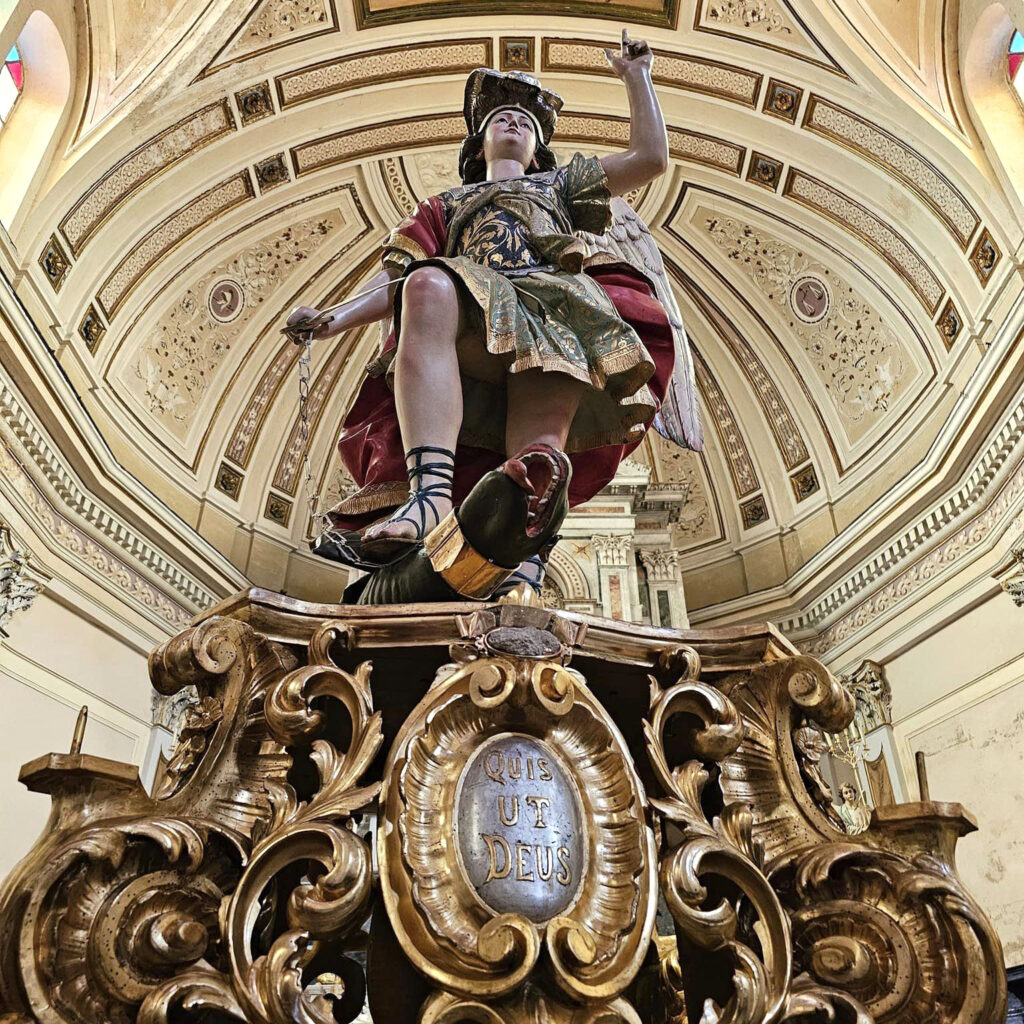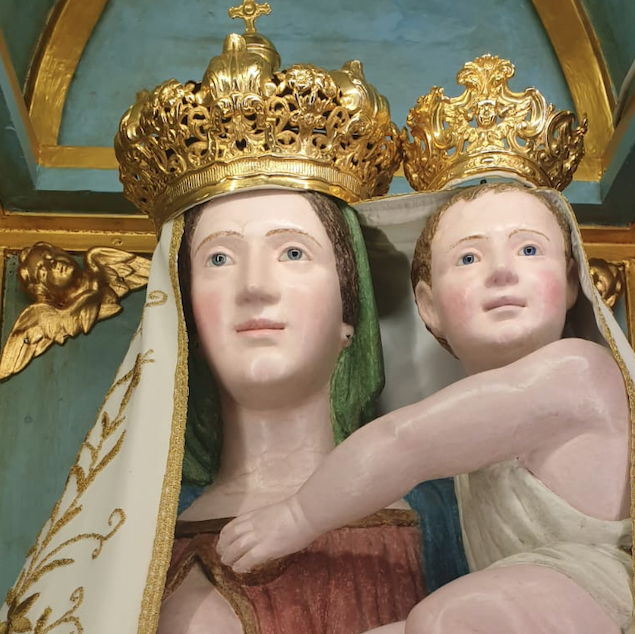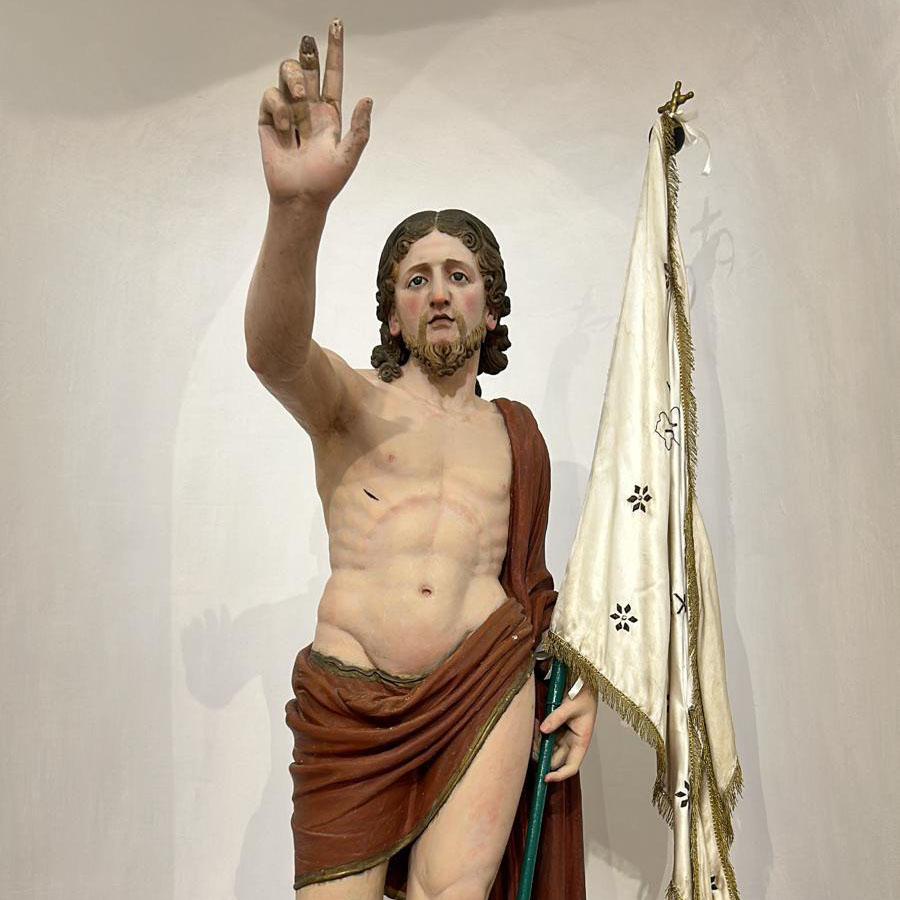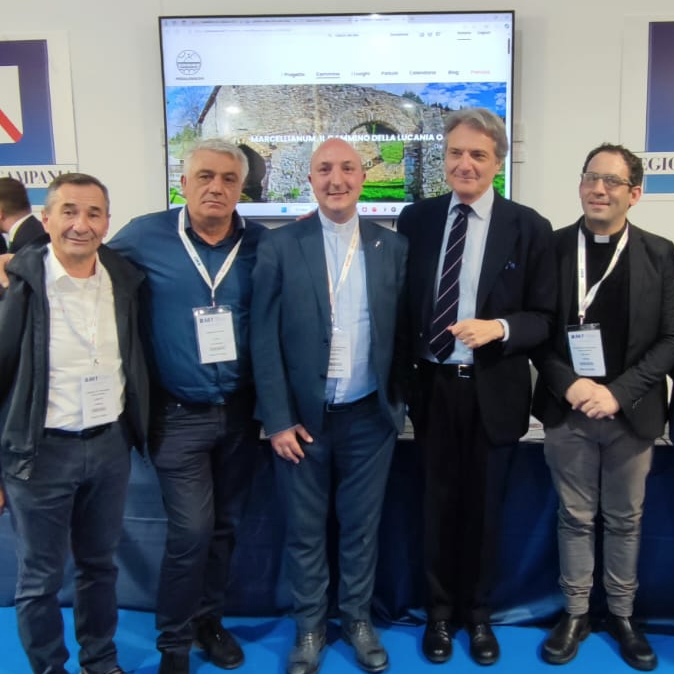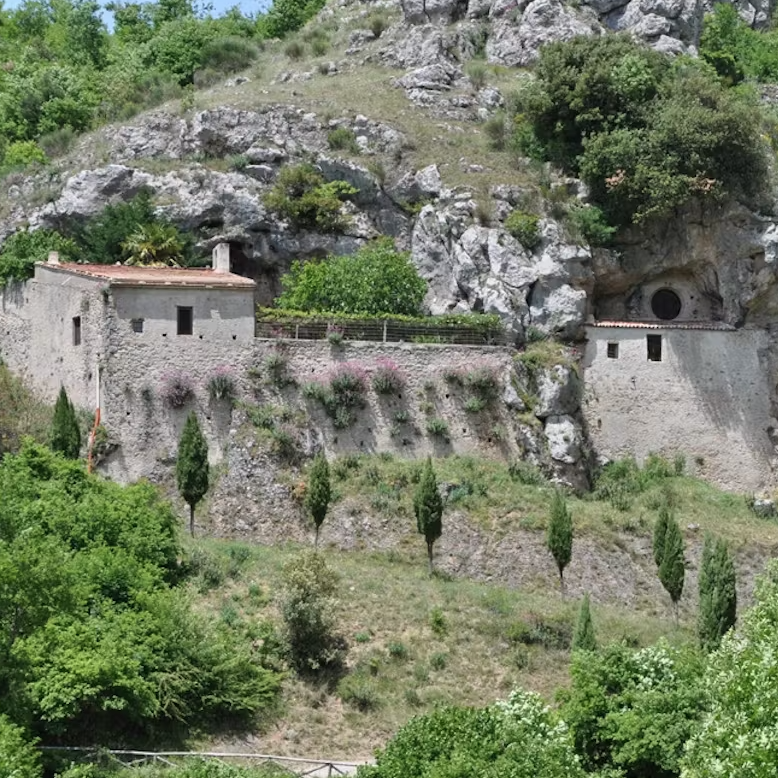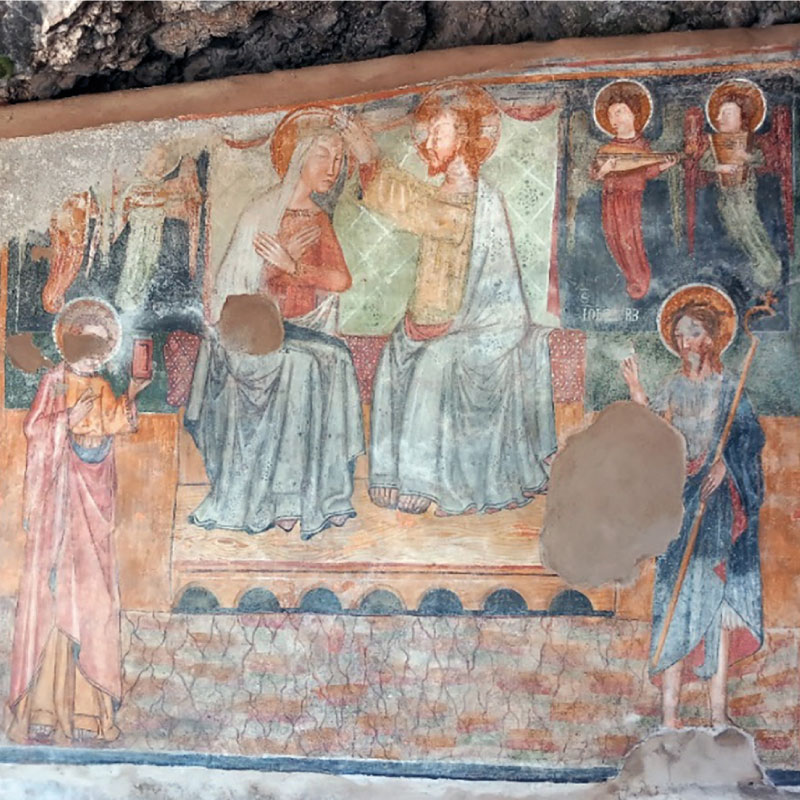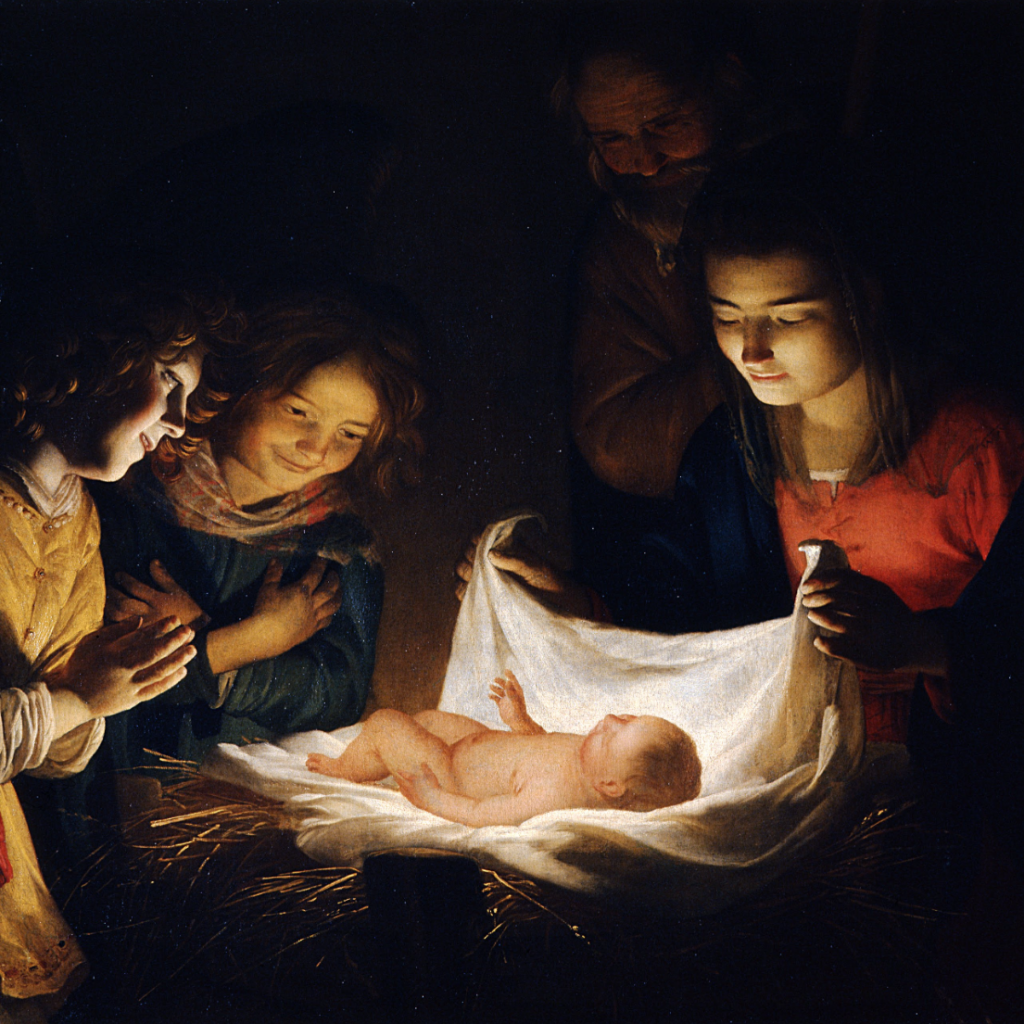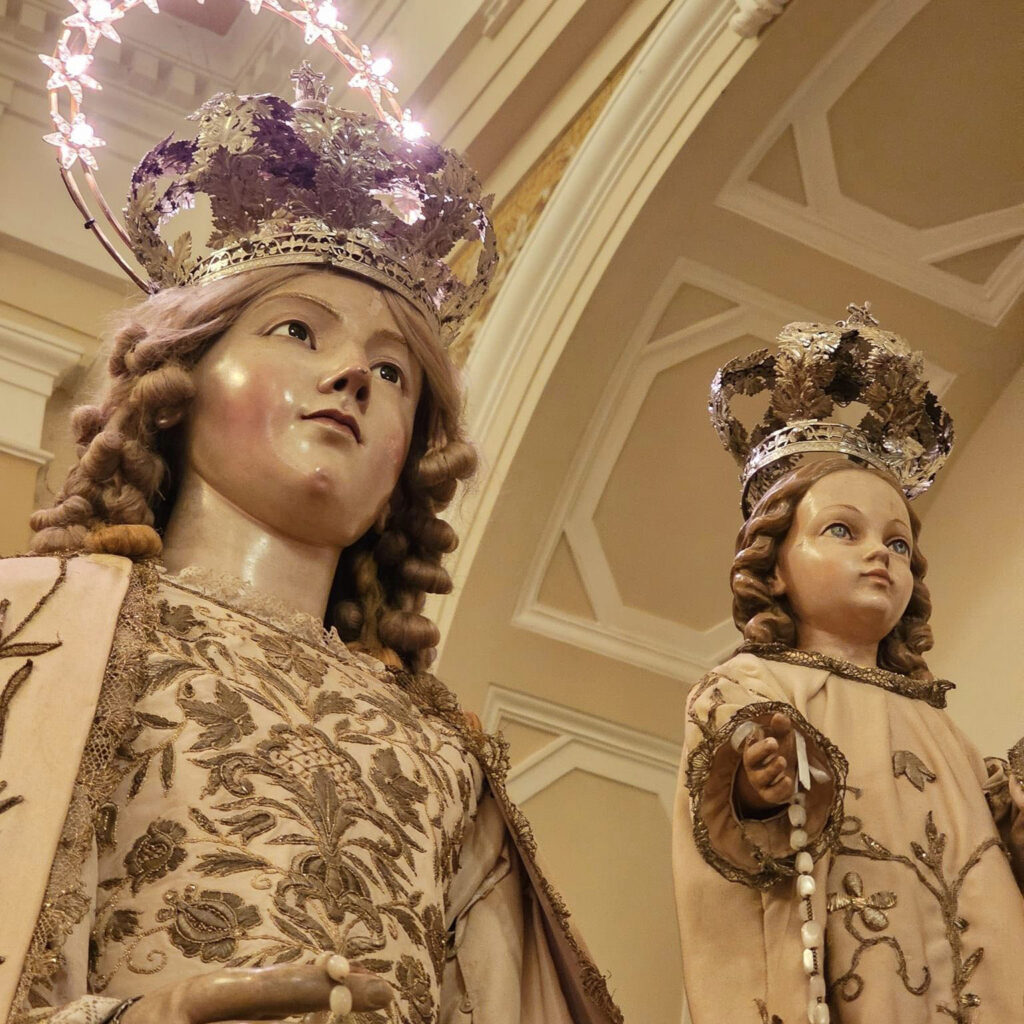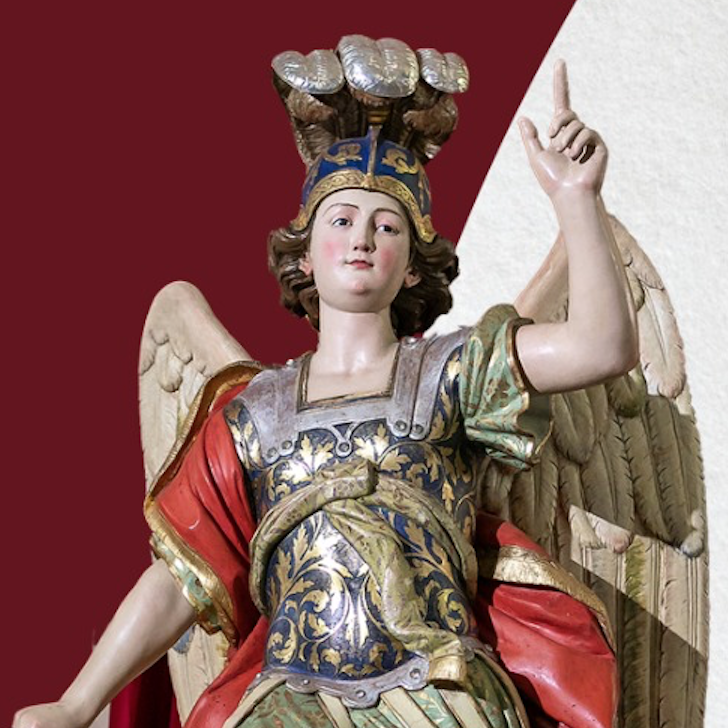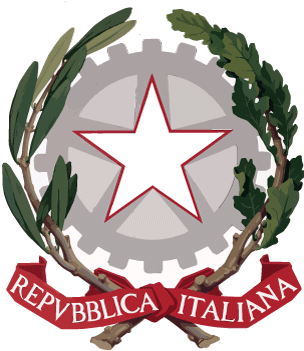First, choose an event o a place to visit
Select the date from the calendar and indicate the number of people to send your booking request.
You will be contacted by our staff. Thank you.
Fill out the form with your data to confirm your booking.
Thank you. Your booking code is {{codice}}, we have sent a summary email to the address {{email}}
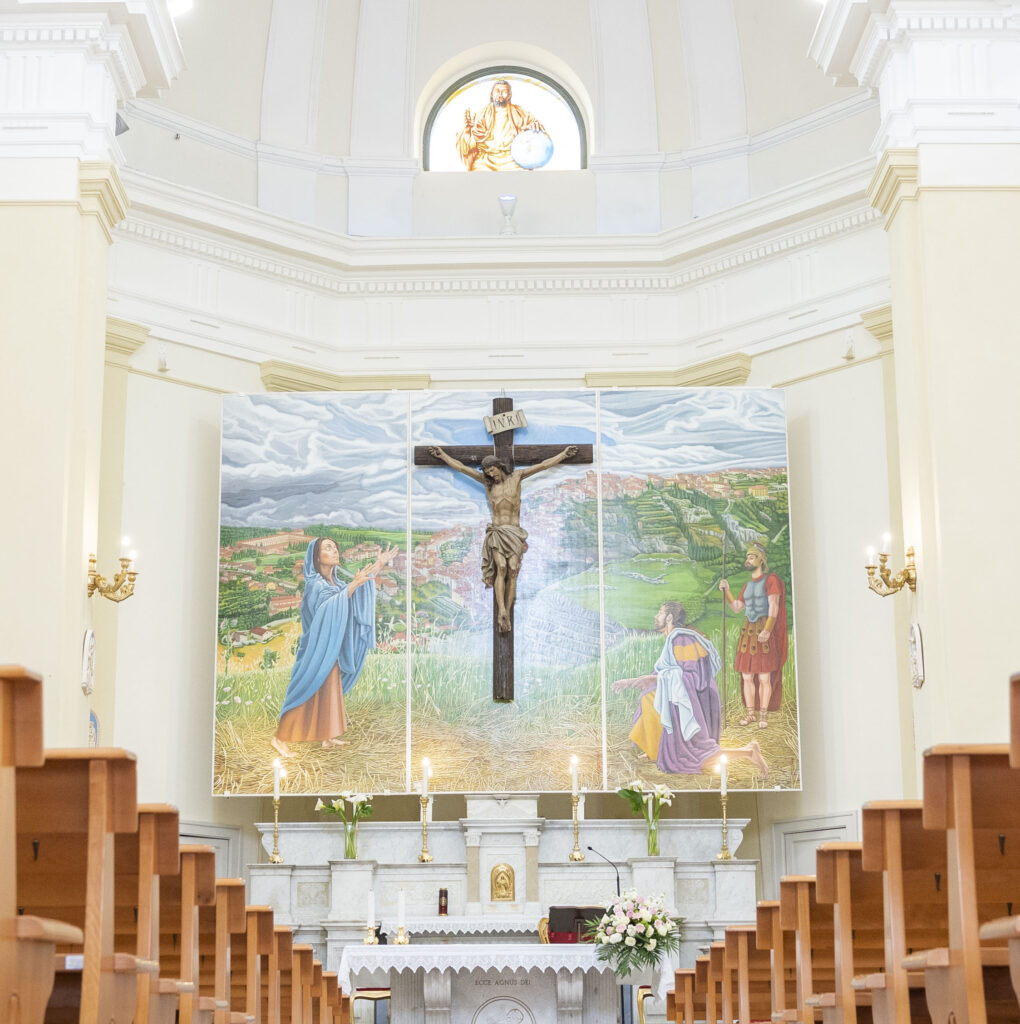
Padula is Jerusalem
Triptych by Maestro Vincenzo D’Acunzo
Church of SS. Announced, Padula (SA)
In front of the acrylic on panel by Maestro Vincenzo D’Acunzo the eyes are attracted by the strength of the light and the harmony of the colours. The spirit is kidnapped knows a brightness that lights up and invites to meditation.
As the gaze penetrates the work, it recognizes the landscape with its real perspectives and shades, in a photographic quality that makes the image the mirror of today’s reality. You can see, masterfully represented, the centuries-old beauties of the city of Padula, the imposing Mother Church of S. Michele Arcangelo and the churches and bell towers of S. Agostino and S. Clemente which can be identified among the houses and palaces on the side of the hill of Padula.
Going down the alleys and paths you reach S. Martino and S. Pietro Petroselli up to S. Giovanni, a house among houses. The gaze moves to the Convent of S. Francesco and in the background, majestic, the Certosa di S. Lorenzo.
In abandoning the mind on the landscape, the thought brings back the ancient seasons of faith, exalting the human mind and spirit while the luxuriant countryside shows the rebirth that the new season inaugurates from the blanket of the now past winter.
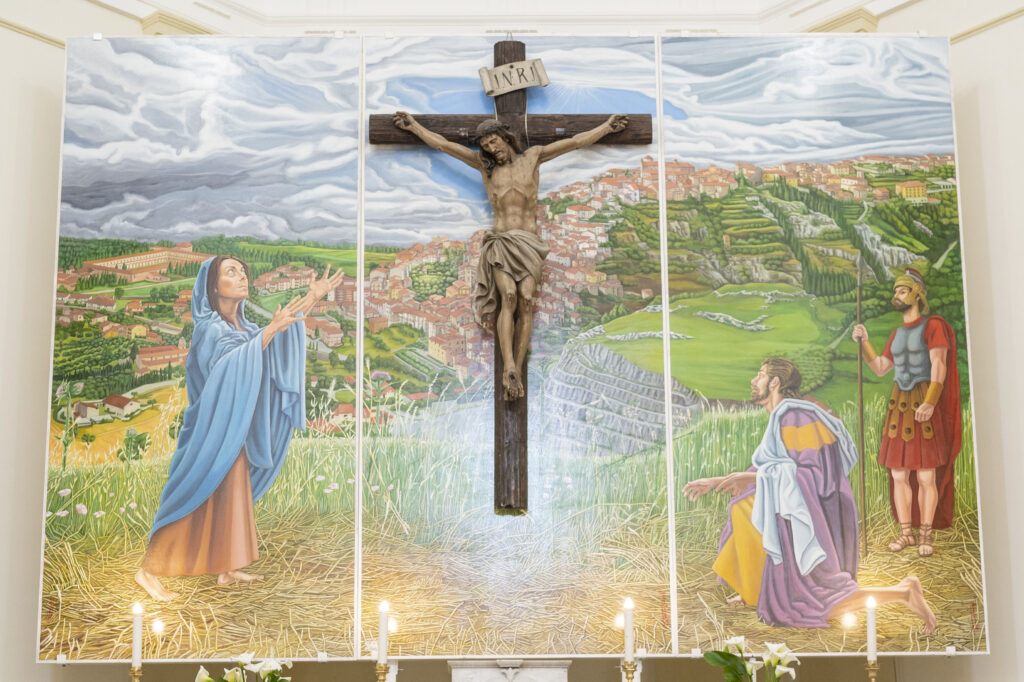
With the eyes of faith boundless horizons open up, difficult to control with thoughts and words,
In the triptych by Maestro D’Acunzo the signs of the presence of the Mystery which modifies and renews history are revealed.
The artist’s sensitive soul introduces us to a known and mysterious horizon that reveals and hides the significant presence of God and rekindles the desire for luminous Beauty in man. It is a spiritual quest that at times has the flavors of wounded joy and healthy comfort. In front of the work Silence is needed! You have to let the heart speak and place your mind in the spatio-temporal contrast it represents. No words, only the eyes, captured by Love, see the Mystery.
From the Colle di San Sepolcro, not far from the ancient Cosilinum, promontory of the Maddalena chain, the vision of the city of Padula and the surrounding area opens up. In an overall vision, which forms the backdrop to Calvary, imagined not far from the Chapel of S. Sepolcro, the gaze is embraced by the green and gold of the countryside, by the sublime elegance of the Virgin and John. The eyes seek their homes and, in the opening of the blue sky, the source of light.
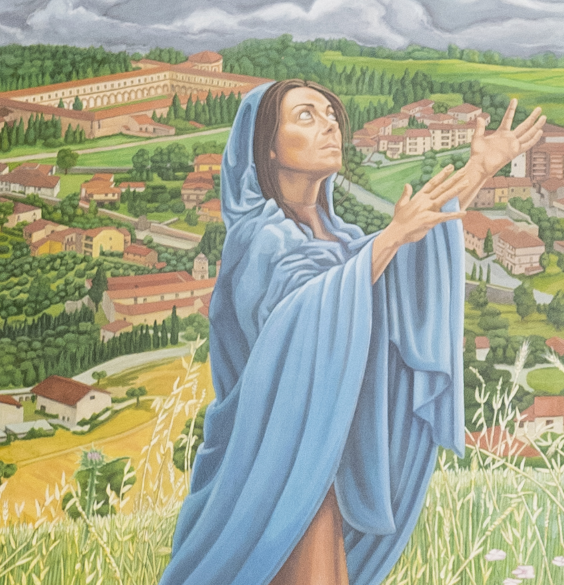
The Virgin Mary, a woman of hope, attracts by her painful sweetness and as she lifts herself off the ground, she also pushes the beholder to raise their heels in an attempt to welcome and embrace her Son. Her face opens to pity and her smile full of tears destroys the crudity of the scene and open the Mystery. The hands of the Virgin, marked by her maternal work, are not reclined on her chest, but are still aimed at carrying out the operation of Salvation, in full communion with her Son, Coredemptrix of the human race.
The eyes of the Virgin contemplate the silence of God where her heart eternally resides and the Word of grace and love resounds. Once again she welcomes the will of the Eternal to renew time. She reopens her womb to welcome her new children, reborn from the water and blood of Christ, and to send them as messengers of Hope, heralds of the resurrection.
The Virgin wears a red robe, a symbol of her humanity and a blue cloak, a symbol of the gracious motherhood and royalty that she exercises over the world. Her hood leaves her long hair uncovered, the vault, even if furrowed by her fatigue and pain, appears radiant with the light that comes from Heaven, from the Father. The simple elegance of the dress presages the wedding that the Son consummated on the banquet of the cross, where he gave his Body and Blood. The Church, looking at the Virgin, contemplates the woman of faith and hope, the woman who is strong in trials and courageous in her martyrdom. Mary’s face leaves a sense of peace and filial abandonment in the heart.
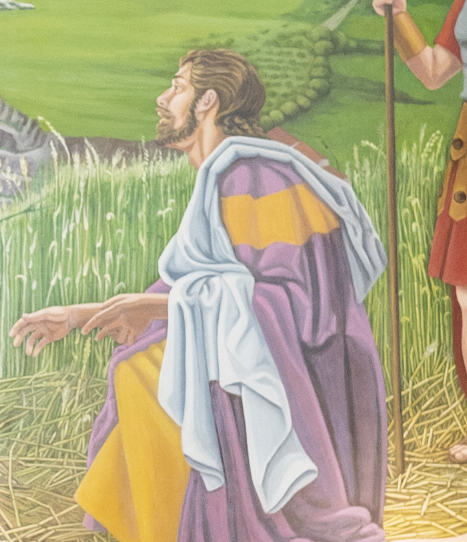
John, kneeling, loses his gaze amidst the incredulity suffered for what the Son has done. The Father’s thunder will have shaken his soul as a “son of thunder”, he will have reviewed his life from the only possible and true perspective: that of charity; once again he will have listened to the Word which returns to the original Silence to be incarnated again with the Spirit in the Apostolic Community.
John will have left the original thoughts of dominion to accept with Mary the only commandment of service and announcement.
The half-open mouth seems to start stammering the Mystery that already rests in his heart as an Apostle and Evangelist. He will have to tell the world the best news: God is Love!
The dangling hands, available because they are empty but also unable to lift themselves, await, imitating the Mother’s already raised hands.
John is already wearing the wedding dress of his favorite son and is holding the Maestri’s tunic on his left shoulder, the seamless one that the soldiers did not want to tear apart “and that heresies have not been able to divide, that is, the charity of God in the Church” (Agostino ). His robe almost completely hides his right foot and leaves the left uncovered, already tense, to raise his body.
The grace of Christ and the love of the Virgin will help the disciple to recover, even with his personal freedom, from the fatigues of discouragement and disappointment. The disciple must be ready to run to tell his brothers: he IS the Lord!
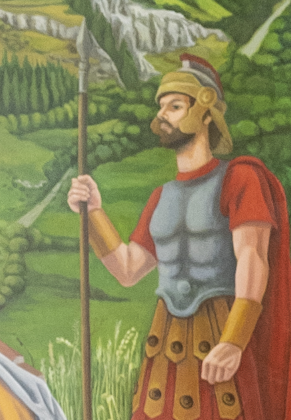
Longinus motionless waits a little longer…
He awaits the orders of mercy from the New King, hanging on the cross. Pagan spectator of the Christian event. All tied up, immobilized by the norms and bonds of paganism. There’s something starting to move: it’s the eyes. They take photos on repeat; from the cry of Jesus to the mercy of the Mother, from the confusion of the crowd to the devastating weakness of the disciples, to the young and precious presence of the only disciple.
To the centurion – when he passed in front of that body and pierced the side of the Criminal with his spear – something happened, he saw something, he heard something, he breathed something. Shocked by the water and blood that came out of that unexpected source, he returned to his place, under his orders! While the right hand supports the last offense to the already dead body of Christ, his left has nothing to hold and is impatient, nervous, unnatural. Something moves in the centurion’s heart: there is an upheaval that touches the depths of his being, there is an act of conversion from religion to faith, from the private habit of his own home to the profession of a universal faith. man was the Son of God! The pagan becomes a model of the Christian: he wears the armor of faith, the helmet of hope, the sword of charity!
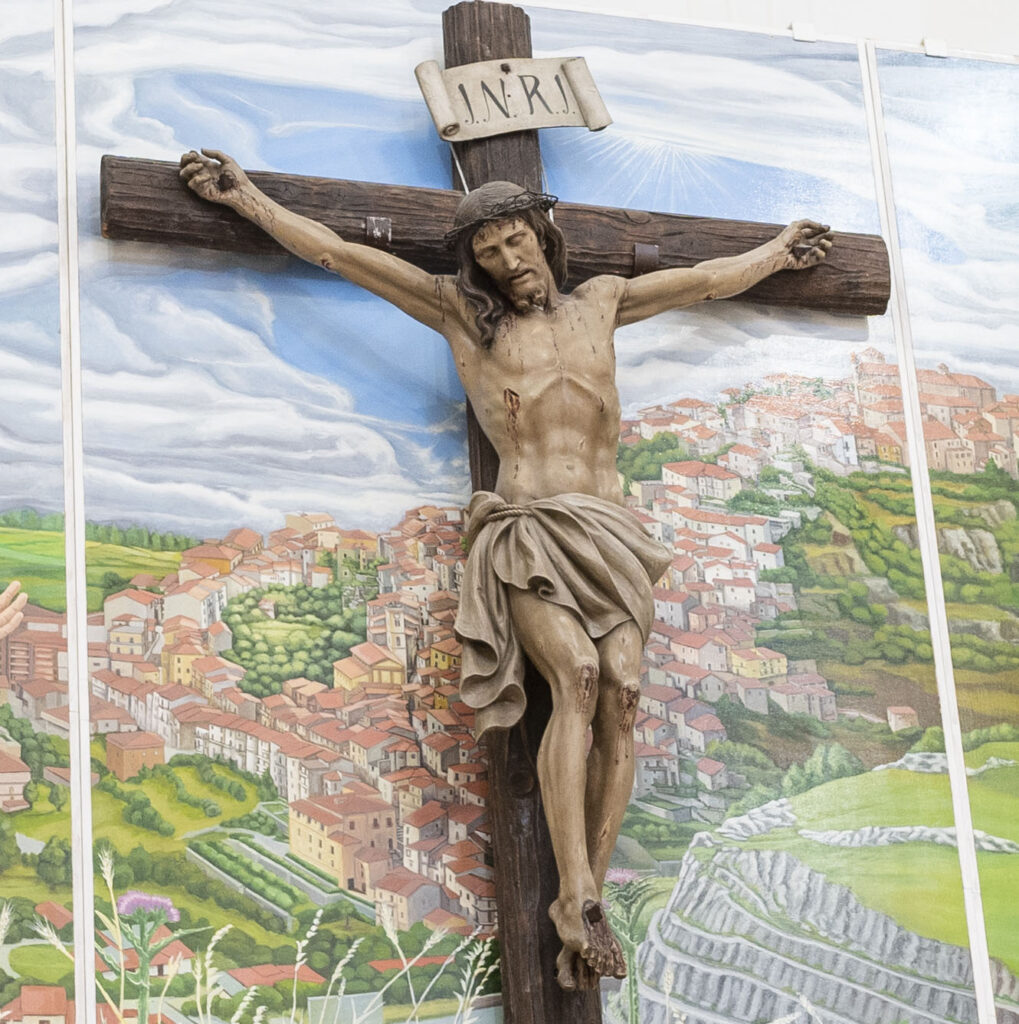
The Crucifix, a work of the Ortisei school, was already installed in the Church of SS. Annunziata since 1997. Purchased in the 1950s, it was the object of devotion by pilgrims who took it professionally to the chapel of S. Sepolcro. Behind the Christ opens the vision of the city of Padula with flowers, Next to the cross the thistle, flower metaphor of the artist’s life, which emerges among the straw and grass that seem to involve the viewer in the dimension of the painting.
Christ with his head bowed on the right side after pronouncing the will to the disciple and to the Mother I emit the spirit. The Virgin Mary welcomes the last breath.
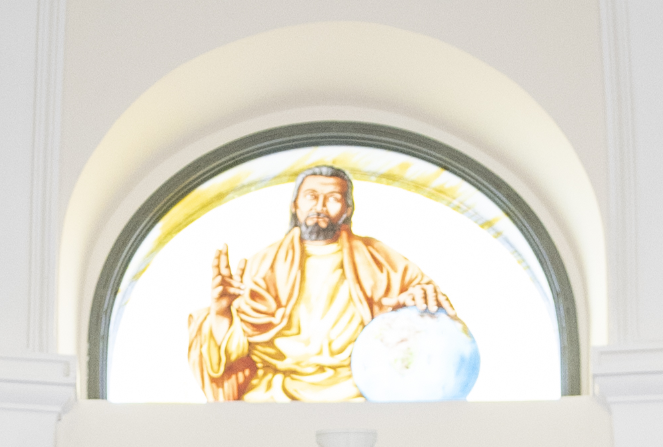
Heaven is the infinite space of God the Father. He opens up infinite horizons on the limited boundaries of human history. The image of the Father, Eternal Youth with the Son and the Holy Spirit, blesses the Sacrifice of Christ and the Church with his Majesty and glory. He governs the world with his Providence and shows the well-known wounds of human poverty, of the sins that still cry out for vengeance in the presence of God, of the mission that the Community has yet to continue. Africa, an exploited and abandoned continent, today asks to be listened to, welcomed, trusted, hoped, especially for those young people who reach our coasts by crossing the sea. Africa is also a reference to the theological and spiritual tradition of Augustine of Hippo who suggests the interpretation of Padula, as an earthly Jerusalem on its way to the Kingdom of the Father.
Padula is Jerusalem: a city that dialogues with history and culture, a fruitful city of faith, cradle of material and spiritual treasures, mother and teacher of talents offered to God, dispenser of beauty for those who inhabit it, live it, love it!
(Text edited by Don Giuseppe Radesca)
The work was donated to the parish by the Campanelli family and is dedicated to Cristian, a young man who died in a road accident.
Maestro Vincenzo D’Acunzo / Bibliographic notes
Born in Padula (SA) in 1950, he lives and works in Tursi (MT) where he got married more than 35 years ago. A multifaceted artist, he began his activity in the early 70s and after a few years he set up personal exhibitions and participated in artistic events that allowed him to have national and international recognition. In 1978 he began to use poor materials for his works and, after a long training process focused on research, in 1992 he arrived at the art of recycling. The installation, made with recycled materials, marks an important stage in the artistic evolution of D’Acunzo who after a few years also begins to devote himself to portraits and sacred art. At Christmas 1993 he performed for the Church of the Sacred Heart of Tursi the installation “L’Evento”, which attracted the attention of regional media and RAI. In the first months of the new millennium he carried out the “Miramare” installation: two facades of over 40 square meters at the entrance to a tourist complex in Roseto Capo Spulico (CS). In 2008 there is the artistic turning point, D’Acunzo realizes for the Cathedral Maria SS. d’Angola by Tursi “Gli Evangelisti”, four ovals which will later be appreciated to the point of being used by Mons. Ottavio Belgio (of Udine) as the cover of 4 texts of reflections on the Evangelists. Two years later he was called to create a work for the ceiling of the same Tursitan cathedral: “The coronation of the Blessed Virgin”. And, again in 2012, he met with great success with the public and critics with the art tour Equilibrio sopra la follia, More than six months of exhibits of works at the table in a tour that touched as many as 11 towns in Basilicata, between Matera and Potenza, and one from Campania: Padula. Since 2011 he has started various artistic and cultural collaborations. With writers, essayists and historians for illustrations, book covers and an unprecedented comparison between literature and painting. And with the online information periodical ilmetapontino.it, with which he has created a free competition with prizes that combines art and culture. In 2012 he performs another work at the Cathedral of Tursi, “The Baptism of Jesus”. In the first months of 2013 he concluded the extraordinary work of three acrylic panels on wood: “Padula is Jerusalem: Crucifixion”. For more information, visit the artist’s website.
Discover the program of celebrations.
